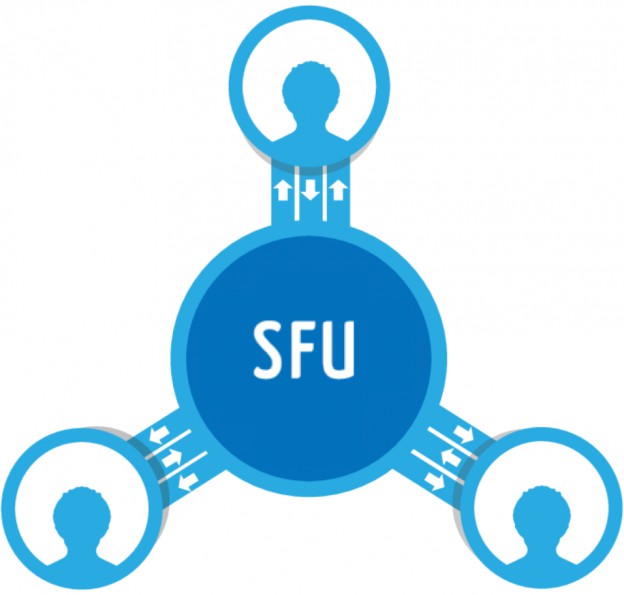Atlassian’s HipChat acquired BlueJimp, the company behind the Jitsi open source project. Other than for positive motivation, why should WebRTC developers care? Well, Jitsi had its Jitsi Video Bridge (JVB) which was one of the few open source Selective Forwarding Units (SFU) projects out there. Jitsi’s founder and past webrtcHacks guest author, Emil Ivov, was a major advocate for this architecture in both the standards bodies and in the public. As we have covered in the past, SFU’s are an effective way to add multiparty video to WebRTC. Beyond this one component, Jitsi was also a popular open source project for its VoIP client, XMPP components, and much more.
So, we had a bunch of questions: what’s new in the SFU world? Is the Jitsi project going to continue? What happens when an open source project gets acquired? Why the recent licensing change?
To answer these questions I reached out to Emil, now Chief Video Architect at Atlassian and Jitsi Project Lead and Joe Lopez, Senior Development and Product Manager at Atlassian who is responsible for establishing and managing Atlassian Open Source program.

webrtcHacks: It has been a while since we have covered multi-party video architectures here. Can you give us some background on what a SFU is and where it helps in WebRTC?
Emil: A Selective Forwarding Unit (SFU) is what allows you to build reliable and scalable multi-party conferences. You can think of them as routers for video, as they receive media packets from all participants and then decide if and who they need to forward them to.
Compared to other conferencing servers, like video mixers – i.e. Multipoint Control Units (MCUs) – SFUs only need a small amount of resources and therefore scale much better. They are also significantly faster as they don’t need to transcode or synchronize media packets, so it is possible to cascade them for larger conferences.
webrtcHacks: is there any effort to standardize the SFU function?
Emil: Yes. It is true that SFUs operate at the application layer, so, strictly speaking, they don’t need to be standard the way IP routers do. Different vendors implement different features for different use cases and things work. Still, as their popularity grows, it becomes more and more useful for people to agree on best practices for SFUs. There is an ongoing effort at the IETF to describe how SFUs generally work: draft-ietf-avtcore-rtp-topologies-update. This helps the community understand how to best build and use them.
Having SFUs well described also helps us optimize other components of the WebRTC ecosystem for them. draft-aboba-avtcore-sfu-rtp-00.txt, for example, talks about how a number of fields that encoders use are currently shared by different codecs (like VP8 and H.264) but are still encoded differently, in codec-specific ways. This is bad as it means developers of more sophisticated SFUs need to suddenly start caring about codecs and the whole point of moving away from MCUs was to avoid doing that. Therefore, works like draft-berger-avtext-framemarking and draft-pthatcher-avtext-esid aim to take shared information out of the media payload and into generic RTP header extensions.
Privacy is another issue that has seen significant activity on the IETF is about improving the end-to-end privacy in SFUs. All existing SFUs today need to decrypt all incoming data before they can process it and forward it to other participants. This obviously puts SFUs in a position to eavesdrop on calls, which, unless you are running your own instance just for yourself, is not a great thing. It also means that the SFU needs to do allocate a lot of processing resources to transcrypting media and avoiding this would improve scalability even further.

webrtcHacks: Other than providing multi-party video functionality, what else do SFU’s like the JVB do?
Emil: Simple straightforward relaying from everyone to everyone – what we call full star routing – means you may end up sending a lot of traffic to a lot of people … potentially more than they care or are able to receive. There are two main ways to address that issue.
First, you can limit the number of streams that everyone receives. This means that in a conference with a hundred participants, rather than getting ninety-nine streams, everyone would only receive the streams for the last four, five or N active speakers. This is what we call Last N and it is something that really helps scalability. Right now N is a number that JVB deployments have as a config param but we are working on making it adaptive so that JVB would adapt it based on link quality.
Another way we improve bandwidth usage is by using “simulcast”. Chrome has the option of generating multiple outgoing video streams in different resolutions. This allows us to pick the higher resolution for active speakers (presumably those are the ones you would want to see in good quality) and resend it to participants who can afford the traffic. It will just relay the lower resolution for and to everyone else.
A few other SFUs, like the one Google Hangouts are using implement simulcast as it saves a lot of resources on the server but also on the client side.We are actually working on some improvements there right now.
webrtcHacks: Joe – now that you have had a chance to get to know the Blue Jimp/Jitsi team and technology, can you give an update on your plans to incorporate Jitsi into HipChat and Atlassian?
Joe: Teams of all sizes use HipChat every day to communicate in real-time all over the world. Teams are stronger when they feel connected, and video is an integral part of that. Users have logged millions of minutes of 1:1 video using HipChat, which helps teams collaborate and build their company culture regardless of whether they work in the same location. With Jitsi we can give users so much more! We’re in the process of developing our own video, audio, and screen-sharing features using Jitsi Video Bridge. It’s a little early for us to comment on exact priority order and timing, but our objective is to make it easier for teams to connect effortlessly anywhere, anytime, on any device.
webrtcHacks: what is the relationship between the core Atlassian team, HipChat, and Jitsi? How does Jitsi fit in your org structure?
Joe: The Jitsi team joined Atlassian as part of HipChat team and makes up the core of our video and real-time communication group. They are experts on all things RTC and we’re now leveraging their expertise. The Jitsi developers are relocating to our Austin offices and will keep working on Jitsi and Atlassian implementations.
webrtcHacks: Can you disclose the terms of the deal?
Emil: I can only say that the acquisition was a great thing for both BlueJimp and Jitsi.
Joe: Same here. We really wanted to add to our team the sort of expertise and technology that BlueJimp brings.
webrtcHacks: I had to try.. So, how big is the Jitsi community? Do you know how many active developers you have using your various projects?

Emil: We haven’t been tracking our users so it’s hard to say. In terms of development, a lot of the work on Jitsi Videobridge and Jitsi Meet is done by BlueJimp, but we are beginning to get some pretty good patches. Hopefully, the trend will continue in that direction.
As for the Jitsi client, we haven’t had a lot of time for it in the past couple of years so community contributions there are likely surpassing those of the company.
webrtcHacks: Your public statements indicate the primary focus of the acquisition was the Jitsi Videobridge. Jitsi had many other popular products, including the Jitsi client, a TURN server, and many others. What is the future of these other projects? Does Atlassian have justification to continue to maintain these elements?
Joe: Our plan is to continue developing the Jitsi Videobridge as well as the other projects including libjitsi, Jitsi Meet, Jirecon, Jigasi and other WebRTC related projects in the Jitsi community. We’re also going to continue providing the build infrastructure for the Jitsi client just as BlueJimp has been doing. But, we don’t have immediate plans for substantial development on the purely client-side.
Emil: It’s worth pointing out that the heart of Jitsi Videobridge, libjitsi, is something it shares with the Jitsi client. There’s also a lot of code that Jigasi, our SIP gateway, imports directly from the client. So, while the upper UX layers in the client are not our main focus, we will continue working heavily on the core.
Above all, however, the developer community around the client is much older and more mature than that of our newer projects. There are developers like Ingo Bauersachs or Danny van Heumen, for example, who have been long involved with the project and who continue working on it. Developers coming and going or changing focus is a natural part of any FLOSS project, and as Joe mentioned, we are going to continue providing the logistics.
webrtcHacks: While Atlassian has initiatives to help open source projects, your core products are not based on open source and you are not known for having many open source projects of its own. Can you address this concern? Is the Jitsi acquisition an attempt to change this? If so, what else has Atlassian done to accommodate more of an open sourcing culture internally?
Joe: Actually, Atlassian uses, supports and develops a number of open source projects. We just haven’t been very vocal about it. That will be changing soon. In addition to managing our real-time communication project, I’m also responsible for our open source program. We’re in the process of restructuring how Atlassian supports open source, and the Jitsi project is one of the first initiatives in our plan. We see Jitsi as a great opportunity, and we are *very* serious about making this project a success. We’ll have more to say about open source later this year.
Finally we think that Jitsi Videobridge is the most advanced open source Selective Forwarding Unit, which puts the team in a unique position to contribute to the WebRTC ecosystem. We are very keen on doing this.
webrtcHacks: last week you moved all the Jitsi licenses from LGPL to Apache.
Emil, why did you choose LGPL in the first place?
Emil: Ever since we started the project, one of our primary motivations had been to get our code in the hands of as many people as possible, so we wanted to lower adoption barriers. Licensing is one of the important components here and, during its very early stages, around 2003, 2004, Jitsi (then SIP Communicator) started with an Apache license.
Then we had to think a little bit more seriously about how we were going to make a living off of our work, because otherwise there wouldn’t have been any project at all. That’s when we thought we might be better off if BlueJimp had protection and decided to switch to LGPL.
So, although it wasn’t our first choice, it did give us a certain measure of protection.
I am very happy that Atlassian has decided to take the risk and relinquish that protection. I firmly believe this is the best option for Jitsi and its users.

webrtcHacks: Joe – why the move to Apache? Why not other licenses like MIT, BSD, etc?
Joe: As for why Apache over MIT/BSD, it’s actually very simple: like at many organizations, Apache is our preferred license of choice when using other people’s open source work. So, it made sense to us that this is what we should choose for our projects. We talked with a number of people internally and externally, and even went so far as to evaluate all licenses. But our technical and legal experts found Apache to be a tried and tested license respected by many organizations for their terms and clarity. At the end of the day we chose Apache because it best fit our organization and others.
webrtcHacks: how do you expect this license change will impact existing Jitsi users?
Emil: Very positively! A number of developers and companies are looking at using Jitsi Videobridge for their new startups, products and services. We expect the Apache license to make Jitsi significantly more appealing to them.
When you are integrating a technology, the more permissive the license is, the less it precludes you from certain choices in the future. When launching a new service or a product, it is very hard to know that you would never need to keep some parts of it proprietary. This is especially true for startups, and I am saying it from experience.
You simply need to keep that option open because sometimes it makes all the difference between a company closing its doors or thriving for years.
That’s the liberty that you get from Apache.
webrtcHacks: the Meet application was previously a MIT license. How are you handling that? Some argue that going from MIT to Apache is a step in the wrong direction.
Emil: That’s true – the first lines of code in the Jitsi Meet project did come under MIT. But there’s not much to handle there. The MIT license allows for code to be redistributed under any other license, including Apache, and Joe already pointed out why we think Apache is a better choice.
Joe: There is also a purely practical side to this. As I mentioned, we’re in the process of restructuring our open source story, and Jitsi is one of the first in this effort. So, it’s important for us to apply the same policy everywhere. The more exceptions we have, the harder it will be to manage and ensure a good experience for any Atlassian contributor.
webrtcHacks: Jitsi was known in the past for soliciting community input before making major decisions. Why didn’t you announce the plans to change your licensing model before the actual change this time?
Emil: Knowing the project as I do, it just never crossed my mind that this would be a problem for anyone. Throughout the past years I only heard concerns from people that found the LGPL too restrictive for them, so I only expected positive opinions. And the overwhelming majority have reacted positively.
For the few people who have raised concerns, let me reiterate that we think this is the best possibility for Jitsi, and we also need to be practical and use a uniform license for all Atlassian projects.
People who feel that LGPL was a better match for them are completely free to take last week’s version of the project and continue maintaining it under that license.
webrtcHacks: what level of transparency can the Jitsi community expect going forward?
Emil: This is actually one of the main ways in which BlueJimp’s acquisition is going to be beneficial to Jitsi.
A lot of the work that BlueJimp did in the past was influenced by customer demand. As a result, we never really knew exactly what to expect a month in the future. This is now over. Today it is much easier for us to define a roadmap and stick to it. Obviously we will still remain flexible as we listen to requests and important use cases from the community, but we are going to have significantly more visibility than before.
webrtcHacks: the github charts indicate a slow down in activity vs. last year. Was this due to distraction from the acquisition? What level of public commits should we expect out of the new Atlassian Jitsi team going forward?
Emil: As with any project, there’s a lot that needs to be done in the early stages. Ninety percent of what you do is push code. This gradually changes with time as the problems you are solving become more complex. At that point you spend a lot of time thinking, testing and debugging. As a result your code output diminishes.
Take our joint efforts with Firefox, for example. This took a lot of time looking through wireshark traces, debugging and making small adjustments. The time it took to actually write the code was negligible compared to everything else we needed to do. Still, adding Firefox compatibility was important to Jitsi, and that happened within Atlassian.
In addition, the entire team is relocating to Austin, and a relocation can be time-consuming.
But, there haven’t been any private commits, if that’s what you are thinking of :).

webrtcHacks: can you share some of your roadmap & plans for Jitsi?
Emil: Gladly! We are really excited to continue working on what makes Jitsi Videobridge the most advanced SFU out there. This includes things like bandwidth adaptivity, for instance. We have big changes coming to our Simulcast and Last N support. Scalability and reliability will also be a main focus in the next months. This includes being able to do more conferences per deployment but also more people per conference. We are also going to be working on mobile, to make it easier for people to use the project on iOS and Android. Supporting other browsers and switching to Maven are also on the roadmap.
We’re not ready to say when, or in what order these things will be happening – but they’re coming.
webrtcHacks: should we expect to see the Jitsi source move from github to bitbucket?
Joe: We’re keeping Jitsi on GitHub, since they excel at being a place for open source projects. Bitbucket is better designed for software teams within organizations that want greater control over their source code, to restrict access within their organization, teams, or even to specific individuals. However, one area that we do want to address is issue tracking. This has been a source of pain for Jitsi, so we’re considering moving issue tracking to JIRA, Atlassian’s issue tracking and management software, which will provide us with everything we need for better project management.
We will be discussing this with the community in the coming weeks.
{“interviewer”, “chad hart“}






While the MIT license allows redistribution, by removing the original copyright from the LICENSE file of meet, you are (trying to) relicense.